Broome to Exmouth
The Pilbara And It's Beautiful
Red Dust
Big prize to be won in this
edition!!!!
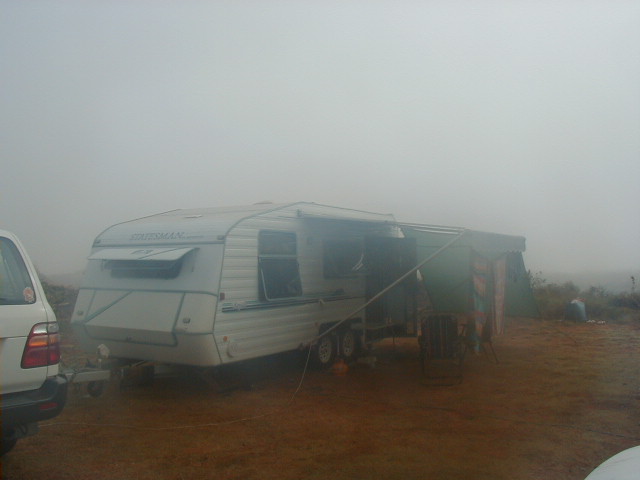 Fog,
I don't Believe This ....Well after nearly a month
in Broome and the Dampier Peninsular it was time to start heading south.
Our first stop was Barn Hill Station, about 140 km south of Broome towards
Port Hedland. This cattle station has developed a caravan
park right on the hills above the coastline about 9 km off the main road
along a sandy track. We took it slowly with the caravan and had no
troubles covering the distance. We spent two days at this park,
which although very basic, met our needs. About a 300 metre
walk from the park brings you to a beautiful beach, and a shell hunters
paradise, especially at low tide. On the first day we
tried our hand at surf fishing with no luck other than a crab that decided
to get one of its claws tangled in our line. The second day was somewhat
unique to us at least. After a very humid night we awoke to
a thick fog that hung around until about three o'clock in the afternoon.
From the caravan park you could not see the water or beach at all and you
could see the fog rolling in from the sea, up the beach and then inland
until the heat of the day burned it up. Truely amazing.
Fog,
I don't Believe This ....Well after nearly a month
in Broome and the Dampier Peninsular it was time to start heading south.
Our first stop was Barn Hill Station, about 140 km south of Broome towards
Port Hedland. This cattle station has developed a caravan
park right on the hills above the coastline about 9 km off the main road
along a sandy track. We took it slowly with the caravan and had no
troubles covering the distance. We spent two days at this park,
which although very basic, met our needs. About a 300 metre
walk from the park brings you to a beautiful beach, and a shell hunters
paradise, especially at low tide. On the first day we
tried our hand at surf fishing with no luck other than a crab that decided
to get one of its claws tangled in our line. The second day was somewhat
unique to us at least. After a very humid night we awoke to
a thick fog that hung around until about three o'clock in the afternoon.
From the caravan park you could not see the water or beach at all and you
could see the fog rolling in from the sea, up the beach and then inland
until the heat of the day burned it up. Truely amazing.
It was then on to Port Smith Lagoon Caravan Park which is about 25 km
further south down the Great Northern Highway and then 23 km out to the
coast. Once again the road to the coast was unmade, sand ,
corrugations and the occasional bulldust. We took it easy with the van
and eventually made the caravan park. Port Smith Lagoon is
a very large tidal lagoon and if you had a boat would be a fisherman's
paradise as there is easy access to the Indian Ocean as well as good fishing
in the lagoon. With no boat you are restricted to fishing in the
lagoon 2 hours before and after low tide. We took the opportunity
to throw in a line and was lucky enough to catch a couple of fish but as
it was not enough for a meal we gave them to the people in the next van
who we were fishing with. With what they caught they had enough for
a reasonable meal.
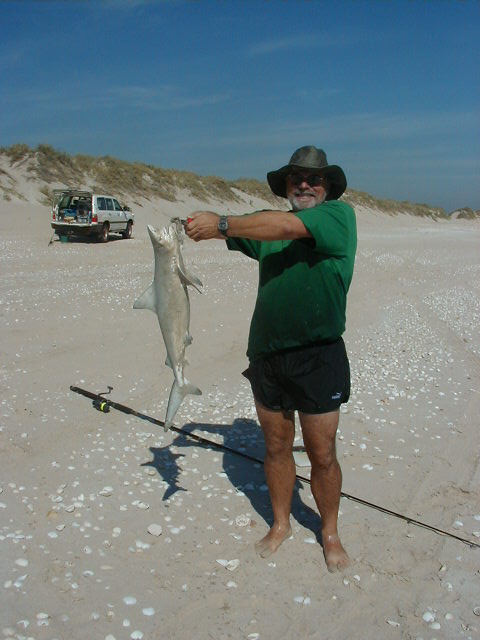 Oh
No, There's Sharks In The Water.....
One night was enough at Port Smith. Been there, done that.
Southward bound again, this time down to 80 Mile Beach Caravan Park which
is about 260 km north of Port Hedland. The caravan park is without
doubt the best along this stretch of coast line. Nice large
grassed sites, clean toilet blocks, a well stocked little mini mart with
reasonable prices and a 300 metre walk to 80 Mile Beach. And what
a beach. At high tide the beach is about 40 metres wide but at low
tide the beach would be close to a kilometre wide. Great for
beach cricket. You could put the MCG on the beach and still
have room for the spectators. We drove the Landcruiser
about 6 km north along the beach and found the fishing is great.
In the space of 3 hours Liz and I, between us, caught 6 small School Sharks,
one good size shark which we filleted and 6 Threadfin Salmon, more than
enough for a few of good meals. The next day we tried our luck again
and was lucky enough to catch another nice Salmon and another reasonable
size School Shark which we filleted and then had enough for about 6 meals.
Liz also spent considerable time partaking in her new found hobby of shell
collecting. If she keeps collecting at the current rate we will have
to buy a bigger caravan in Perth to carry all the shell.
Oh
No, There's Sharks In The Water.....
One night was enough at Port Smith. Been there, done that.
Southward bound again, this time down to 80 Mile Beach Caravan Park which
is about 260 km north of Port Hedland. The caravan park is without
doubt the best along this stretch of coast line. Nice large
grassed sites, clean toilet blocks, a well stocked little mini mart with
reasonable prices and a 300 metre walk to 80 Mile Beach. And what
a beach. At high tide the beach is about 40 metres wide but at low
tide the beach would be close to a kilometre wide. Great for
beach cricket. You could put the MCG on the beach and still
have room for the spectators. We drove the Landcruiser
about 6 km north along the beach and found the fishing is great.
In the space of 3 hours Liz and I, between us, caught 6 small School Sharks,
one good size shark which we filleted and 6 Threadfin Salmon, more than
enough for a few of good meals. The next day we tried our luck again
and was lucky enough to catch another nice Salmon and another reasonable
size School Shark which we filleted and then had enough for about 6 meals.
Liz also spent considerable time partaking in her new found hobby of shell
collecting. If she keeps collecting at the current rate we will have
to buy a bigger caravan in Perth to carry all the shell.
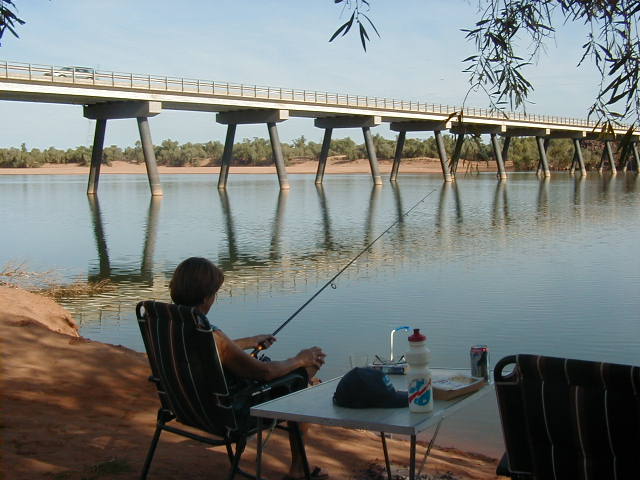 The
Longest Coffee Break..... After four days at
Eighty Mile Beach it was time to head towards Port Hedland and restock
for our trip into Karijini National Park. Approximately 70 kms from
Port Hedland, we came across this off road stop at the De Grey River.
We were there only for a coffee break and two nights later, running out
of wine and potatoes we decided that we better move on. Our caravan
door was about 3 metres from the waters edge and we had a view up and down
the river. We certainly spent a relaxing time watching the world
go by and throwing in the fishing line but was only fortunate enough to
catch one bream. There were a number of caravan and camp sites along
the banks of this river which is 250 metres wide. By coincidence
we caught up with a couple who we had met last year in Mt Isa and again
on the Barkley Highway. It is really a small world.
The
Longest Coffee Break..... After four days at
Eighty Mile Beach it was time to head towards Port Hedland and restock
for our trip into Karijini National Park. Approximately 70 kms from
Port Hedland, we came across this off road stop at the De Grey River.
We were there only for a coffee break and two nights later, running out
of wine and potatoes we decided that we better move on. Our caravan
door was about 3 metres from the waters edge and we had a view up and down
the river. We certainly spent a relaxing time watching the world
go by and throwing in the fishing line but was only fortunate enough to
catch one bream. There were a number of caravan and camp sites along
the banks of this river which is 250 metres wide. By coincidence
we caught up with a couple who we had met last year in Mt Isa and again
on the Barkley Highway. It is really a small world.
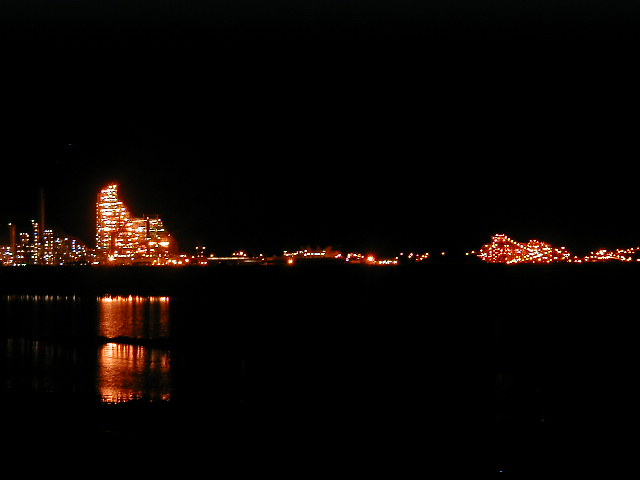 It's
A Big Town, It Has A K Mart....
It's
A Big Town, It Has A K Mart....
A short trip into Port Hedland saw us obtain the second last caravan
site at Cooke Point Caravan Park, one of the nicest parks in Port and South
Hedland. Port Hedland is a real mining town with BHP Iron Ore mineral
facilities dominating the town. Nine trains per day leave for the
mines near Newman and Tom Price. Each train has 240 cars hauled
by four 4,000 horsepower locomotives - two in the front and two near the
middle - making each train 2.6 kms in length. Another industry in
Port Hedland is the Cargill Salt Works which can stockpile up to 550,000
tonnes which is exported to Japan, Taiwan, Korea and the Philippines.
Whilst Port Hedland is really just an industrial city it does come to life
at night with a spectacular light show from the BHP Iron Ore operations.
This gives the entire town an almost carnival atmosphere.
A sandy 4WD track to the 'Rock of Ages" at Cooke Point, saw us once
again throwing in our fishing lines. Rob caught four big mackerel
(60 cm in length) and a nice trevally within 30 minutes. It was truly
amazing. At least 30 fisherman were fishing from this point and everyone
was catching them. We actually were able to give some of our fillets to
our neighbours next door as our freezer was bulging at the seams.
A beautiful meal of marinated teriyaki mackerel and white wine (now back
in stock in our cellar) with plenty left over for other meals (mackerel
and wine that is). How many ways can you cook mackerel?
Wittenoon, Asbestos, Quick,
Hold Your Breath...... After two nights in
Port Hedland it was time to leave for Karijini National Park (formerly
Hammersley Ranges). We have heard such fantastic reports about this
area that we were really looking forward to spending time exploring the
area. Our first stop had to be Wittenoon. What we expected
was a ghost town with nobody living there, big signs up warning of no entry
and locked gates. Surprise, surprise. It is not
a ghost town but in our estimates it won't be long. There are
about 30 people still living in the main township of Wittenoon, it has
a tourist bureau, a gem store and a small milk bar/tea rooms in a private
house. We ventured in to the actual mine site in Wittenoon Gorge
which we expected to be barred and locked but instead was confronted with
both some derelict building as well as some well maintained buildings which
people are living in. We stopped to find why they are living
right at the mine site only to be told they are the caretakers on behalf
of the government of WA who now own the entire town. Apparently all
the buildings at the mine site as well as the township were to be demolished
back in 1996 but due to government delays nothing has happened.
The Adventure Park, Karijini
National Park .... After a night at Auski Roadhouse
put to sleep by the drone of the diesel generator it was time to move on
to Karijini National Park. A 70 km drive on first class bitumen roads
to the park entrance and then another 10 km on a dirt road to the Fortescue
camping area which was to be our base for the next four days. Whilst
very basic; no power, no grass, no showers and lot's of red dust it did
have nice clean pit toilets. We have found, without doubt, that the
Hammersley red dust is the dustiest, dirtiest red dust in all Australia,
basically because it is made up of iron oxide (rust).
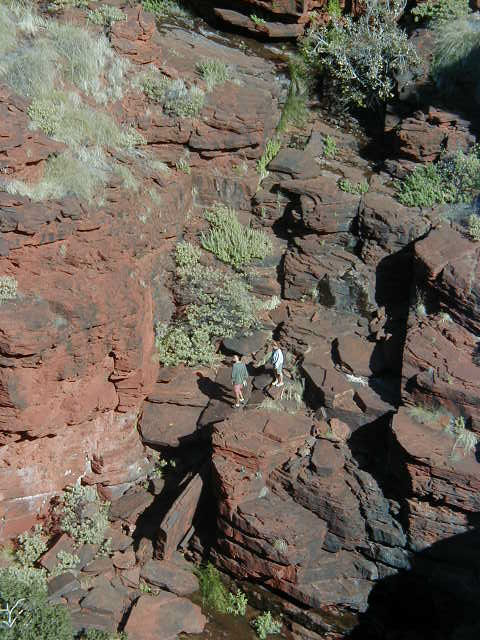 Karijini National
Park has to be one of the most spectacular National Parks in Australia.
The many gorges that scatter the ranges, expose the dominant layering and
sediments which make them some of the oldest land forms in the world.
The walk trails in the heart of the gorges wind past waterfalls, permanent
rock pools and areas filled with lush vegetation which is a contrast to
the rich red rock faces of the gorge walls. For the adventurer these
gorges provide some interesting and challenging walks where you have to
descend down steep cliffs, walk and swim through icy cold water to get
from one section of the gorge to the next and climb down waterfalls hanging
on to hand rails and knotted rope. Because of the big wet season
there is still lot's of water around and water falls such as Joffre Falls
which are normally dry in the dry season still had lot's of water flowing.
This means that areas of the gorge normally dry are filled edge to edge
with icy cold water.
Karijini National
Park has to be one of the most spectacular National Parks in Australia.
The many gorges that scatter the ranges, expose the dominant layering and
sediments which make them some of the oldest land forms in the world.
The walk trails in the heart of the gorges wind past waterfalls, permanent
rock pools and areas filled with lush vegetation which is a contrast to
the rich red rock faces of the gorge walls. For the adventurer these
gorges provide some interesting and challenging walks where you have to
descend down steep cliffs, walk and swim through icy cold water to get
from one section of the gorge to the next and climb down waterfalls hanging
on to hand rails and knotted rope. Because of the big wet season
there is still lot's of water around and water falls such as Joffre Falls
which are normally dry in the dry season still had lot's of water flowing.
This means that areas of the gorge normally dry are filled edge to edge
with icy cold water.
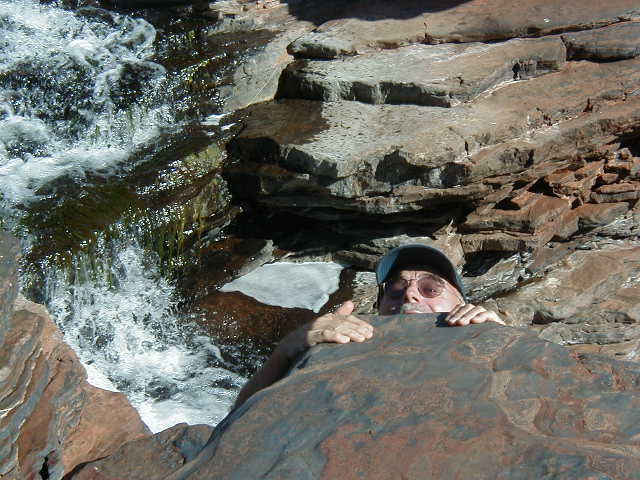 Not to be outdone
by the back packers and younger tourists we took all the challenges of
the gorge walks on with enthusiasm and gusto but not without some minor
bruising and dented egos. You really do need a good level of
fitness to climb in and out of these gorges which can be up to 100 metres
deep. Over the four days we were in the park, we successfully
negotiated all the gorge walks. In a number of cases we had to swim
through icy cold and quite deep water to get to the next section of the
gorge or climb along slippery rocky ledges to avoid the water. Some
of these gorges come to an abrupt end at very narrow chasms and waterfalls,
and to proceed further you need climbing gear and other equipment.
As the photo shows Rob had a 'brush with death' at Joffre Falls when he
slipped and was left clinging to a rock ledge with an 80 metre drop to
the gorge floor. After taking the photo Liz saved him from near certain
death. What a lady!
Not to be outdone
by the back packers and younger tourists we took all the challenges of
the gorge walks on with enthusiasm and gusto but not without some minor
bruising and dented egos. You really do need a good level of
fitness to climb in and out of these gorges which can be up to 100 metres
deep. Over the four days we were in the park, we successfully
negotiated all the gorge walks. In a number of cases we had to swim
through icy cold and quite deep water to get to the next section of the
gorge or climb along slippery rocky ledges to avoid the water. Some
of these gorges come to an abrupt end at very narrow chasms and waterfalls,
and to proceed further you need climbing gear and other equipment.
As the photo shows Rob had a 'brush with death' at Joffre Falls when he
slipped and was left clinging to a rock ledge with an 80 metre drop to
the gorge floor. After taking the photo Liz saved him from near certain
death. What a lady!
 Mount
Tom Price, No Tom Price... This
town was established in 1966 to support the iron ore project established
by Hammersley Iron. Originally this town was called Mt Tom
Price but the powers that be at Hammersley Iron wisely renamed the town
Tom Price when they realised they were mining away the mountain of the
same name. It would really have looked stupid to have a town named
after a mountain that did not exist. As it is the other big mountain
on the edge of Tom Price is called Mount Nameless. Engineers
don't seem to have any artistic flare when it comes to naming things, but
boy have they built a fantastic sandpit. The mine tour is a must
see at Tom Price and gives an excellent perspective of just how big these
projects are. The ore is shipped to the coast at Dampier via a private
railway using trains 2.2 km in length and weighing 24,000 tonnes.
Obviously big sand pits require big trains.
Mount
Tom Price, No Tom Price... This
town was established in 1966 to support the iron ore project established
by Hammersley Iron. Originally this town was called Mt Tom
Price but the powers that be at Hammersley Iron wisely renamed the town
Tom Price when they realised they were mining away the mountain of the
same name. It would really have looked stupid to have a town named
after a mountain that did not exist. As it is the other big mountain
on the edge of Tom Price is called Mount Nameless. Engineers
don't seem to have any artistic flare when it comes to naming things, but
boy have they built a fantastic sandpit. The mine tour is a must
see at Tom Price and gives an excellent perspective of just how big these
projects are. The ore is shipped to the coast at Dampier via a private
railway using trains 2.2 km in length and weighing 24,000 tonnes.
Obviously big sand pits require big trains.
The visit to Tom Price was a bit of a nostalgia
trip for me (Rob) as I had been involved in the early 70's with setting
up airconditioning systems in the mineworkers residences and offices.
Whilst the town has grown substantially since then, many of the houses
still have the original airconditioners fitted. Just amazing.
One of the landmarks that was still there and I remember fondly was the
hotel. Whilst extended and now managed by Mercure Inns the original
section of the hotel is still there with the same bar. I walked
in to take a look and some guy walked up to me and said, "hey Bob, we wondered
where you got to, it's your shout".
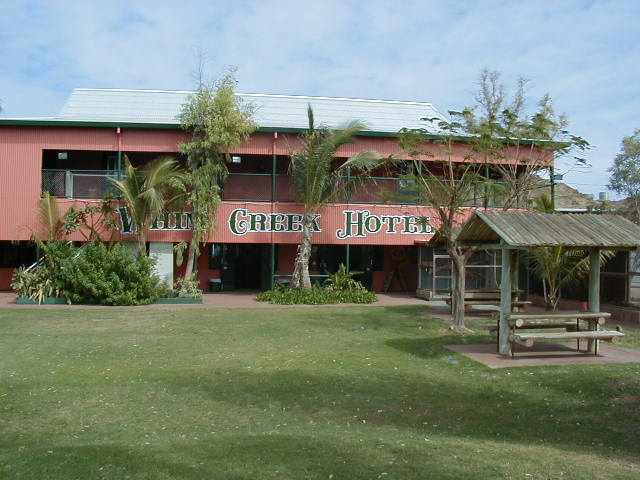 Whim
Creek, An Outback Legend....
Our next stop was the Whim Creek hotel on our way to Karratha.
Another nostalgia trip for me (Rob) as I visited there on one of the trips
up to this region again in the early 70's. On December 15, 1999 this
hotel, which is on the highway about 80 kms north of Roebourne, was hit
by Cyclone John and the top half of the hotel and many of the motel units
were destroyed. The hotel has now been rebuilt but retains it's quaint
turn of the century appearance. At 10.30 in the morning it was crowded
not with beer drinkers but with people ordering morning tea and coffee.
Anything to make a quid I guess. From Whim Creek it was down
to Roebourne for an overnight stop to enable us to visit historic Cossack
and the following day on to Karratha for a car service and to restock the
pantry. Karratha is a modern, well laid out mining town built
by Hammersley Iron in the late 60's and early 70's. It has
excellent shopping, hospital and sporting facilities but apart from the
mine tours not a lot for the tourist. If you had access to a boat
then you have the Dampier Archipelago to explore which I am sure would
be interesting.
Whim
Creek, An Outback Legend....
Our next stop was the Whim Creek hotel on our way to Karratha.
Another nostalgia trip for me (Rob) as I visited there on one of the trips
up to this region again in the early 70's. On December 15, 1999 this
hotel, which is on the highway about 80 kms north of Roebourne, was hit
by Cyclone John and the top half of the hotel and many of the motel units
were destroyed. The hotel has now been rebuilt but retains it's quaint
turn of the century appearance. At 10.30 in the morning it was crowded
not with beer drinkers but with people ordering morning tea and coffee.
Anything to make a quid I guess. From Whim Creek it was down
to Roebourne for an overnight stop to enable us to visit historic Cossack
and the following day on to Karratha for a car service and to restock the
pantry. Karratha is a modern, well laid out mining town built
by Hammersley Iron in the late 60's and early 70's. It has
excellent shopping, hospital and sporting facilities but apart from the
mine tours not a lot for the tourist. If you had access to a boat
then you have the Dampier Archipelago to explore which I am sure would
be interesting.
The
highlight of this section:
Another easy decision.
The visit to Karijini National Park. The unspoiled beauty of this
national park, the spectacular gorges, the contrasting colours of the red
earth and prolific foliage make this a special place. For the adventurous
it provides challenging walks and swims. We were lucky enough to visit
the park when the wild flowers were in bloom which added to the beauty
of the park.
Until our next update.
Regards, Rob
& Liz
p.s. In our East Kimberley report
we told the story of the horse at Diggers Rest Camp that was seriously
injured as a result of a crocodile attack. A phone call back
to Diggers Rest provided us with the sad news that the horse had to be
put down. A gental reminder of what a salt water crocodile can do
to animals and humans.
QUICKIE QUIZ
Question: What town
(as the crow flies) on the Australian Continent is the furthest from Ballarat?
Answer: In our next web page update.
Prize: We will send a prize
to the first person to email us with the neatest correct answer.
Note: Email's
with attachments automatically disqualified, no correspondence will be
entered into, judges decision is final.(This is the fine print)
Page now complete - No further updates
to this page.
 Oh
No, There's Sharks In The Water.....
One night was enough at Port Smith. Been there, done that.
Southward bound again, this time down to 80 Mile Beach Caravan Park which
is about 260 km north of Port Hedland. The caravan park is without
doubt the best along this stretch of coast line. Nice large
grassed sites, clean toilet blocks, a well stocked little mini mart with
reasonable prices and a 300 metre walk to 80 Mile Beach. And what
a beach. At high tide the beach is about 40 metres wide but at low
tide the beach would be close to a kilometre wide. Great for
beach cricket. You could put the MCG on the beach and still
have room for the spectators. We drove the Landcruiser
about 6 km north along the beach and found the fishing is great.
In the space of 3 hours Liz and I, between us, caught 6 small School Sharks,
one good size shark which we filleted and 6 Threadfin Salmon, more than
enough for a few of good meals. The next day we tried our luck again
and was lucky enough to catch another nice Salmon and another reasonable
size School Shark which we filleted and then had enough for about 6 meals.
Liz also spent considerable time partaking in her new found hobby of shell
collecting. If she keeps collecting at the current rate we will have
to buy a bigger caravan in Perth to carry all the shell.
Oh
No, There's Sharks In The Water.....
One night was enough at Port Smith. Been there, done that.
Southward bound again, this time down to 80 Mile Beach Caravan Park which
is about 260 km north of Port Hedland. The caravan park is without
doubt the best along this stretch of coast line. Nice large
grassed sites, clean toilet blocks, a well stocked little mini mart with
reasonable prices and a 300 metre walk to 80 Mile Beach. And what
a beach. At high tide the beach is about 40 metres wide but at low
tide the beach would be close to a kilometre wide. Great for
beach cricket. You could put the MCG on the beach and still
have room for the spectators. We drove the Landcruiser
about 6 km north along the beach and found the fishing is great.
In the space of 3 hours Liz and I, between us, caught 6 small School Sharks,
one good size shark which we filleted and 6 Threadfin Salmon, more than
enough for a few of good meals. The next day we tried our luck again
and was lucky enough to catch another nice Salmon and another reasonable
size School Shark which we filleted and then had enough for about 6 meals.
Liz also spent considerable time partaking in her new found hobby of shell
collecting. If she keeps collecting at the current rate we will have
to buy a bigger caravan in Perth to carry all the shell.
 Fog,
I don't Believe This ....Well after nearly a month
in Broome and the Dampier Peninsular it was time to start heading south.
Our first stop was Barn Hill Station, about 140 km south of Broome towards
Port Hedland. This cattle station has developed a caravan
park right on the hills above the coastline about 9 km off the main road
along a sandy track. We took it slowly with the caravan and had no
troubles covering the distance. We spent two days at this park,
which although very basic, met our needs. About a 300 metre
walk from the park brings you to a beautiful beach, and a shell hunters
paradise, especially at low tide. On the first day we
tried our hand at surf fishing with no luck other than a crab that decided
to get one of its claws tangled in our line. The second day was somewhat
unique to us at least. After a very humid night we awoke to
a thick fog that hung around until about three o'clock in the afternoon.
From the caravan park you could not see the water or beach at all and you
could see the fog rolling in from the sea, up the beach and then inland
until the heat of the day burned it up. Truely amazing.
Fog,
I don't Believe This ....Well after nearly a month
in Broome and the Dampier Peninsular it was time to start heading south.
Our first stop was Barn Hill Station, about 140 km south of Broome towards
Port Hedland. This cattle station has developed a caravan
park right on the hills above the coastline about 9 km off the main road
along a sandy track. We took it slowly with the caravan and had no
troubles covering the distance. We spent two days at this park,
which although very basic, met our needs. About a 300 metre
walk from the park brings you to a beautiful beach, and a shell hunters
paradise, especially at low tide. On the first day we
tried our hand at surf fishing with no luck other than a crab that decided
to get one of its claws tangled in our line. The second day was somewhat
unique to us at least. After a very humid night we awoke to
a thick fog that hung around until about three o'clock in the afternoon.
From the caravan park you could not see the water or beach at all and you
could see the fog rolling in from the sea, up the beach and then inland
until the heat of the day burned it up. Truely amazing.
 The
Longest Coffee Break..... After four days at
Eighty Mile Beach it was time to head towards Port Hedland and restock
for our trip into Karijini National Park. Approximately 70 kms from
Port Hedland, we came across this off road stop at the De Grey River.
We were there only for a coffee break and two nights later, running out
of wine and potatoes we decided that we better move on. Our caravan
door was about 3 metres from the waters edge and we had a view up and down
the river. We certainly spent a relaxing time watching the world
go by and throwing in the fishing line but was only fortunate enough to
catch one bream. There were a number of caravan and camp sites along
the banks of this river which is 250 metres wide. By coincidence
we caught up with a couple who we had met last year in Mt Isa and again
on the Barkley Highway. It is really a small world.
The
Longest Coffee Break..... After four days at
Eighty Mile Beach it was time to head towards Port Hedland and restock
for our trip into Karijini National Park. Approximately 70 kms from
Port Hedland, we came across this off road stop at the De Grey River.
We were there only for a coffee break and two nights later, running out
of wine and potatoes we decided that we better move on. Our caravan
door was about 3 metres from the waters edge and we had a view up and down
the river. We certainly spent a relaxing time watching the world
go by and throwing in the fishing line but was only fortunate enough to
catch one bream. There were a number of caravan and camp sites along
the banks of this river which is 250 metres wide. By coincidence
we caught up with a couple who we had met last year in Mt Isa and again
on the Barkley Highway. It is really a small world.
 It's
A Big Town, It Has A K Mart....
It's
A Big Town, It Has A K Mart....
 Karijini National
Park has to be one of the most spectacular National Parks in Australia.
The many gorges that scatter the ranges, expose the dominant layering and
sediments which make them some of the oldest land forms in the world.
The walk trails in the heart of the gorges wind past waterfalls, permanent
rock pools and areas filled with lush vegetation which is a contrast to
the rich red rock faces of the gorge walls. For the adventurer these
gorges provide some interesting and challenging walks where you have to
descend down steep cliffs, walk and swim through icy cold water to get
from one section of the gorge to the next and climb down waterfalls hanging
on to hand rails and knotted rope. Because of the big wet season
there is still lot's of water around and water falls such as Joffre Falls
which are normally dry in the dry season still had lot's of water flowing.
This means that areas of the gorge normally dry are filled edge to edge
with icy cold water.
Karijini National
Park has to be one of the most spectacular National Parks in Australia.
The many gorges that scatter the ranges, expose the dominant layering and
sediments which make them some of the oldest land forms in the world.
The walk trails in the heart of the gorges wind past waterfalls, permanent
rock pools and areas filled with lush vegetation which is a contrast to
the rich red rock faces of the gorge walls. For the adventurer these
gorges provide some interesting and challenging walks where you have to
descend down steep cliffs, walk and swim through icy cold water to get
from one section of the gorge to the next and climb down waterfalls hanging
on to hand rails and knotted rope. Because of the big wet season
there is still lot's of water around and water falls such as Joffre Falls
which are normally dry in the dry season still had lot's of water flowing.
This means that areas of the gorge normally dry are filled edge to edge
with icy cold water.
 Not to be outdone
by the back packers and younger tourists we took all the challenges of
the gorge walks on with enthusiasm and gusto but not without some minor
bruising and dented egos. You really do need a good level of
fitness to climb in and out of these gorges which can be up to 100 metres
deep. Over the four days we were in the park, we successfully
negotiated all the gorge walks. In a number of cases we had to swim
through icy cold and quite deep water to get to the next section of the
gorge or climb along slippery rocky ledges to avoid the water. Some
of these gorges come to an abrupt end at very narrow chasms and waterfalls,
and to proceed further you need climbing gear and other equipment.
As the photo shows Rob had a 'brush with death' at Joffre Falls when he
slipped and was left clinging to a rock ledge with an 80 metre drop to
the gorge floor. After taking the photo Liz saved him from near certain
death. What a lady!
Not to be outdone
by the back packers and younger tourists we took all the challenges of
the gorge walks on with enthusiasm and gusto but not without some minor
bruising and dented egos. You really do need a good level of
fitness to climb in and out of these gorges which can be up to 100 metres
deep. Over the four days we were in the park, we successfully
negotiated all the gorge walks. In a number of cases we had to swim
through icy cold and quite deep water to get to the next section of the
gorge or climb along slippery rocky ledges to avoid the water. Some
of these gorges come to an abrupt end at very narrow chasms and waterfalls,
and to proceed further you need climbing gear and other equipment.
As the photo shows Rob had a 'brush with death' at Joffre Falls when he
slipped and was left clinging to a rock ledge with an 80 metre drop to
the gorge floor. After taking the photo Liz saved him from near certain
death. What a lady!
 Mount
Tom Price, No Tom Price... This
town was established in 1966 to support the iron ore project established
by Hammersley Iron. Originally this town was called Mt Tom
Price but the powers that be at Hammersley Iron wisely renamed the town
Tom Price when they realised they were mining away the mountain of the
same name. It would really have looked stupid to have a town named
after a mountain that did not exist. As it is the other big mountain
on the edge of Tom Price is called Mount Nameless. Engineers
don't seem to have any artistic flare when it comes to naming things, but
boy have they built a fantastic sandpit. The mine tour is a must
see at Tom Price and gives an excellent perspective of just how big these
projects are. The ore is shipped to the coast at Dampier via a private
railway using trains 2.2 km in length and weighing 24,000 tonnes.
Obviously big sand pits require big trains.
Mount
Tom Price, No Tom Price... This
town was established in 1966 to support the iron ore project established
by Hammersley Iron. Originally this town was called Mt Tom
Price but the powers that be at Hammersley Iron wisely renamed the town
Tom Price when they realised they were mining away the mountain of the
same name. It would really have looked stupid to have a town named
after a mountain that did not exist. As it is the other big mountain
on the edge of Tom Price is called Mount Nameless. Engineers
don't seem to have any artistic flare when it comes to naming things, but
boy have they built a fantastic sandpit. The mine tour is a must
see at Tom Price and gives an excellent perspective of just how big these
projects are. The ore is shipped to the coast at Dampier via a private
railway using trains 2.2 km in length and weighing 24,000 tonnes.
Obviously big sand pits require big trains.
 Whim
Creek, An Outback Legend....
Our next stop was the Whim Creek hotel on our way to Karratha.
Another nostalgia trip for me (Rob) as I visited there on one of the trips
up to this region again in the early 70's. On December 15, 1999 this
hotel, which is on the highway about 80 kms north of Roebourne, was hit
by Cyclone John and the top half of the hotel and many of the motel units
were destroyed. The hotel has now been rebuilt but retains it's quaint
turn of the century appearance. At 10.30 in the morning it was crowded
not with beer drinkers but with people ordering morning tea and coffee.
Anything to make a quid I guess. From Whim Creek it was down
to Roebourne for an overnight stop to enable us to visit historic Cossack
and the following day on to Karratha for a car service and to restock the
pantry. Karratha is a modern, well laid out mining town built
by Hammersley Iron in the late 60's and early 70's. It has
excellent shopping, hospital and sporting facilities but apart from the
mine tours not a lot for the tourist. If you had access to a boat
then you have the Dampier Archipelago to explore which I am sure would
be interesting.
Whim
Creek, An Outback Legend....
Our next stop was the Whim Creek hotel on our way to Karratha.
Another nostalgia trip for me (Rob) as I visited there on one of the trips
up to this region again in the early 70's. On December 15, 1999 this
hotel, which is on the highway about 80 kms north of Roebourne, was hit
by Cyclone John and the top half of the hotel and many of the motel units
were destroyed. The hotel has now been rebuilt but retains it's quaint
turn of the century appearance. At 10.30 in the morning it was crowded
not with beer drinkers but with people ordering morning tea and coffee.
Anything to make a quid I guess. From Whim Creek it was down
to Roebourne for an overnight stop to enable us to visit historic Cossack
and the following day on to Karratha for a car service and to restock the
pantry. Karratha is a modern, well laid out mining town built
by Hammersley Iron in the late 60's and early 70's. It has
excellent shopping, hospital and sporting facilities but apart from the
mine tours not a lot for the tourist. If you had access to a boat
then you have the Dampier Archipelago to explore which I am sure would
be interesting.